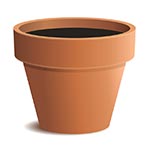Carrot seeds
11/10/2024Black eggplant seeds
11/10/2024Dill seeds or “scented dill”
It is a herbaceous plant used in cooking and cosmetics. Growing dill seeds is not difficult, but it does require a little knowledge to successfully bear fruit.
Prepare the soil for dill seeds
Dill requires fertile, well-drained soil. It prefers sandy clay soil that contains a good percentage of organic matter. Before planting, it is recommended to prepare the soil by adding organic fertilizers to provide the plants with the necessary nutrients.
Planting dill seeds
Dill seeds are planted in straight lines to a depth of about 0.5-1 cm. It is preferable to plant the seeds in a place that receives direct sunlight for at least 6 hours a day. The distance between seeds should be about 15-20 cm to ensure there is enough room for growth.
Irrigation and germination
After planting the seeds, the soil must be irrigated regularly to keep it moist but not saturated with water. Dill seeds usually take 10 to 14 days to germinate. The planted area can be covered with a light layer of straw to maintain moisture and protect the seeds from birds.
Plant care
Weeds that may grow around the plants should be removed regularly. A light organic fertilizer can be added every few weeks to promote plant growth. Dill is a fast-growing plant and can be harvested about 40-60 days after planting.
Pest and disease control
Dill is resistant to most pests and diseases, but it may occasionally be attacked by insects such as whiteflies and aphids. It is recommended to monitor the plants regularly and take necessary measures as soon as any signs of infection appear.
Harvesting and storage
Dill leaves can be harvested when the plants reach 15-25 cm in height. The leaves are best harvested fresh for immediate use, but can be dried or frozen to preserve for longer periods.
Crop rotation
It is a good idea to practice crop rotation to avoid soil depletion and protect plants from diseases. Dill can be grown in a different area each season rather than in the same place, which helps maintain healthy soil and reduces the chance of disease spreading.
Uses of dill
In addition to its culinary uses, dill can be used in herbal remedies to help soothe the digestive system and promote respiratory health. Dill has antibacterial and anti-inflammatory properties, making it beneficial for overall health.
Natural reproduction
Dill tends to self-reproduce if left unharvested. After the growing season ends, the seeds can fall to the ground to grow the following season. You can also collect and save seeds for later planting.
Effect of light and heat
Dill prefers to grow in locations that receive full sun, but it can also tolerate partial shade. The optimum temperature for growing dill ranges between 15-25 degrees Celsius, which makes it suitable for planting in the spring and fall.
Growing dill in ponds
If you don’t have enough space in the garden, dill seeds can be planted in tubs or large pots. Make sure the pots have adequate drainage holes to prevent excess water buildup.
Dill has well-drained soil. The soil density should be between wet and dry. The desired growth can lead to change but the alternative in the body is to cause mold to rot.
Wind protection
The stems can be slightly broken by strong winds. It is best to grow dill seeds in areas protected from evil winds or use natural or artificial wind shields to protect them.
Dill should be stored well for its flavor and health benefits. The item can be stored in the refrigerator in a small plastic bag, and can also be frozen for later use.
Health benefits of dill
Dill is known for its many health benefits. Since it has few antioxidant properties, it is a good source of vitamins such as vitamin C and iron.
Growing dill from seed to harvest
Dill seeds grow well if planted in spring or fall. It is preferable to plant dill in a place that receives direct sunlight. The soil temperature should be around 15°C to ensure successful germination
Using dill in the kitchen
Dill is widely used in cooking, to add a refreshing flavor to dishes. It can be added to salads, soups, main dishes and even bread. Fresh or dried leaves can be used, and the seeds can also be used to add a distinctive flavour.
Environmental benefits
Dill attracts beneficial insects, such as bees and butterflies, to the garden. These insects contribute to pollinating other plants, which increases the productivity of the garden. Also, dill can be grown alongside other plants as a companion plant, which helps deter some pests.
Health benefits of dill
In addition to vitamins A and C, dill contains antioxidant compounds that help fight free radicals in the body. It is thought to have sedative and antispasmodic effects, making it useful for soothing the digestive system and improving sleep.
Harvesting techniques
When harvesting dill, the stems should be cut off near the base. It is best to harvest early in the morning when essential oils are at their highest. Seeds can be collected when the flower heads begin to dry out and turn brown.
We have dill seeds available at Garden Hub
This dill is a simple plant that is easy to grow and has many benefits. It is always fun to grow aromatic plants and benefit from them in the kitchen and in everyday life. What do you think now? Would you like to try growing dill?








